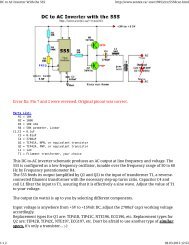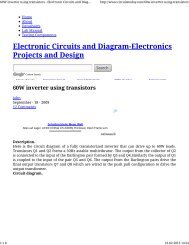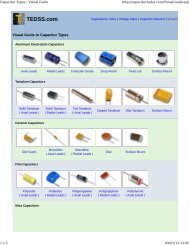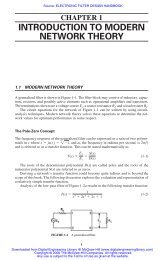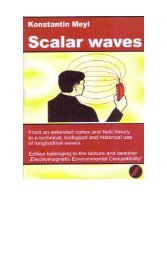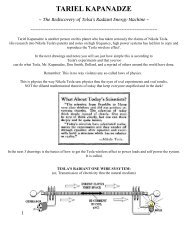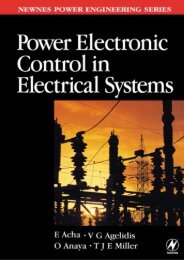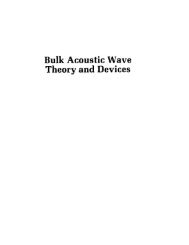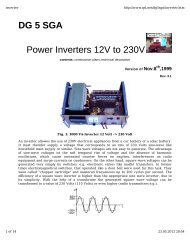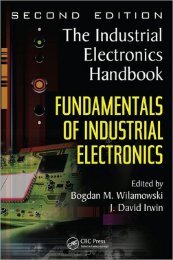New Energy Technologies Magazine nr 3 2005.pdf - Index of
New Energy Technologies Magazine nr 3 2005.pdf - Index of
New Energy Technologies Magazine nr 3 2005.pdf - Index of
Create successful ePaper yourself
Turn your PDF publications into a flip-book with our unique Google optimized e-Paper software.
Despite ineptitude <strong>of</strong> such an "exposure", the<br />
scientific community could more easily believe<br />
in the complete incompetence <strong>of</strong> Pr<strong>of</strong>essor<br />
Gravesande, prince Karl and other respectable<br />
participants <strong>of</strong> numerous tests <strong>of</strong> Orffyreus'<br />
wheel than assume the possibility <strong>of</strong> existence<br />
<strong>of</strong> a phenomenon, which was beyond the<br />
established ideology. In 1775, Paris Academy<br />
<strong>of</strong> Sciences refused to consider perpetual<br />
motion machines at all because they did not<br />
exist. And the same Academy refused to<br />
consider the existence <strong>of</strong> meteorites because<br />
the possibility <strong>of</strong> stones falling from the sky was<br />
thought absurd. After the law <strong>of</strong> energy<br />
conservation had been formulated in the XIX<br />
century, the question <strong>of</strong> the possibility <strong>of</strong><br />
perpetual motion machines' existence was<br />
finally buried as contradicting mathematical<br />
and physical laws. A paradoxical situation <strong>of</strong>ten<br />
happened when a working device posed as a<br />
Perpetuum mobile was demonstrated but no<br />
scientifically grounded refutation followed.<br />
Usually such a situation ended up with a<br />
magazine lampoon, as it happened in the case <strong>of</strong><br />
Orffyreus' wheel.<br />
A perpetuum mobile model shown at Paris<br />
exhibition in the middle <strong>of</strong> XIX century can be<br />
an example <strong>of</strong> such a pseudo-exposure. The<br />
engine had a form <strong>of</strong> a continuously rotating<br />
wheel with weights moving inside it. People<br />
interested could stop it by making a strong<br />
effort; after that the wheel continued rotating.<br />
A journalistic "exposure" <strong>of</strong> the perpetuum<br />
mobile was a presence <strong>of</strong> a spring in the wheel.<br />
Ostensibly, the spring became twisted during<br />
the device's stop and was a source <strong>of</strong> rotation<br />
energy. It is interesting that no scientists<br />
disputed such an "exposure".<br />
How can the law <strong>of</strong> energy conservation work if<br />
the engine's wheel continues rotating while<br />
energy is always spent for its stop Possibly, there<br />
was a flywheel inside a wheel with the spring<br />
attached to it, which became twisted during the<br />
wheel's stop by the flywheel's inertia while a<br />
locking device connected to the frame prevented<br />
the flywheel from untwisting. Thus, the spring<br />
created the effort necessary for starting the<br />
wheel's motion after a stop. Further motion could<br />
happen only due to the weights' motion inside the<br />
wheel. By the way, Orffyreus' wheel needed an<br />
effort imparting initial velocity <strong>of</strong> rotation, too.<br />
Undoubtedly, due to the shirking position <strong>of</strong> the<br />
scientists, many perpetuum mobile projects<br />
originated from wrong suppositions but this does<br />
not mean that all demonstrated models were the<br />
results <strong>of</strong> a counterfeit or incompetence. An<br />
objective <strong>of</strong> real science is the search for truth<br />
instead <strong>of</strong> conservation <strong>of</strong> the previous paradigm<br />
at any price. That is why, if there are facts<br />
contradicting it, they should be objectively<br />
studied and, if necessary, the science paradigm<br />
should be changed instead <strong>of</strong> rejecting the facts<br />
without grounds.<br />
The regular crisis <strong>of</strong> physics happening in the end<br />
<strong>of</strong> the XX and the beginning <strong>of</strong> XXI centuries<br />
makes scientists revise many physical theses. For<br />
example, the question <strong>of</strong> existence <strong>of</strong> aether or<br />
"physical vacuum", which is a medium having<br />
inexhaustible reserves <strong>of</strong> potential energy where<br />
electromagnetic waves spread, is the order <strong>of</strong> the<br />
day again.<br />
The existing idea <strong>of</strong> the nature <strong>of</strong> matter and force<br />
fields, particularly the gravity one, must be revised.<br />
Finally, it is time to understand what the<br />
fundamental concepts, force and mass are because<br />
physics is still satisfied with the ideas <strong>of</strong> the XVIII<br />
century, when force was determined by mass and<br />
mass was determined by inertia. And it is still not<br />
understood what inertia is. Probably, the scientific<br />
paradigm, particularly the physics' one, can<br />
greatly change soon. The changes can also concern<br />
the existing interpretation <strong>of</strong> the law <strong>of</strong> energy<br />
conservation and, therefore, the scientific<br />
approach to the possibility <strong>of</strong> designing <strong>of</strong> the<br />
perpetuum mobile, i.e. a device able to produce<br />
yield using energy from a force field or directly<br />
from physical vacuum.<br />
In order to hasten this process, besides a<br />
description <strong>of</strong> another perpetual motion<br />
machine's design given in this article, it is<br />
suggested to consider its validity from the<br />
physics' point <strong>of</strong> view not overstepping the limits<br />
<strong>of</strong> the existing paradigm except the ban against<br />
the possibility <strong>of</strong> such a machine's existence.<br />
A basic model <strong>of</strong> the suggested gravity engine<br />
consists <strong>of</strong> hollow cylinders with pistons fixed at<br />
a flexible base <strong>of</strong> the type <strong>of</strong> a closed belt. The<br />
base is stretched on two freely rotating wheels<br />
with axles, placed one under another, fixed on the<br />
frame. Moving around the wheels, the belt with<br />
22 <strong>New</strong> <strong>Energy</strong> <strong>Technologies</strong> #3(22) 2005



